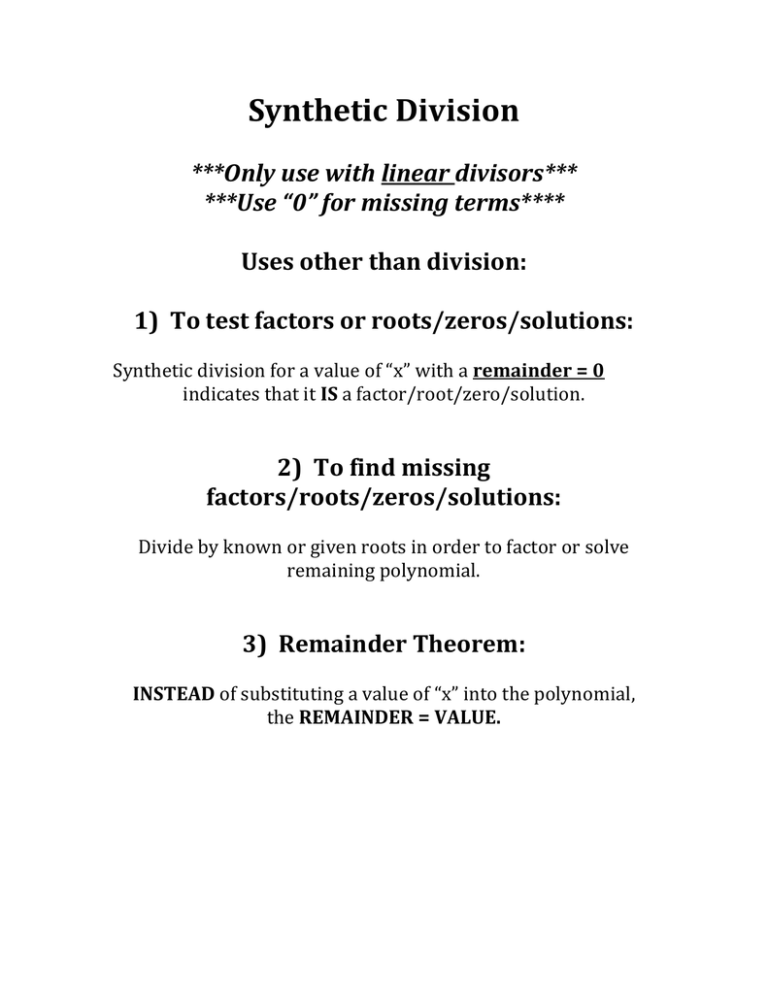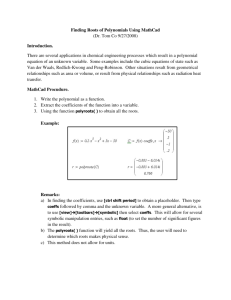1) To test factors or roots/zeros/solutions
advertisement

Synthetic Division ***Only use with linear divisors*** ***Use “0” for missing terms**** Uses other than division: 1) To test factors or roots/zeros/solutions: Synthetic division for a value of “x” with a remainder = 0 indicates that it IS a factor/root/zero/solution. 2) To find missing factors/roots/zeros/solutions: Divide by known or given roots in order to factor or solve remaining polynomial. 3) Remainder Theorem: INSTEAD of substituting a value of “x” into the polynomial, the REMAINDER = VALUE. DIVISION OF POLYNOMIALS Synthetic Division ***Only use with linear divisors*** ***Use “0” for missing terms**** ***Value of “x” goes in “box”*** ***Bring down 1st coefficient, multiply, add*** ***Each division reduces degree by 1*** ***Numbers represent new coefficients*** Long Division ***Use with ANY divisor*** ***Use “0x” for any missing terms*** ***Same process as for numbers: Divide, Multiply, Subtract, Bring down*** Finding Polynomials ***Use roots/zeros to write factors*** ***Always have OPPOSITE of irrational and imaginary roots too*** ***Multiply factors and combine like terms*** ***Write in standard form*** Binomial Expansion ***use instead of multiplying binomial factor by itself repeatedly*** ***Use row of numbers from Pascal’s Triangle with descending powers of first term and ascending powers of last term*** Graphing Polynomials End Behavior ***Describes the direction of the right and left ends of a polynomial function*** ***Depends of if degree is EVEN (both same direction) or ODD (opposite directions) and sign of “a” (+ right side up, -- right side down)*** Roots/ Zeros ***Real roots/zeros represent X-INTERCEPTS*** Solving/Finding roots or zeros By factoring: ***Check for and factor GCF*** ***Technique depends on number of terms*** 2 terms: formula sum of cubes : (𝒂 + 𝒃)(𝒂𝟐 − 𝒂𝒃 + 𝒃𝟐 ) difference of cubes: (𝒂 − 𝒃)(𝒂𝟐 + 𝒂𝒃 + 𝒃𝟐 ) difference of squares: (𝒂 + 𝒃)(𝒂 − 𝒃) ***no sum of squares*** 3 terms: guess and check 4 terms: grouping ***set each factor = 0 and solve*** Rational Root Theorem ***use when you can’t factor*** ***possible roots = ±𝒇𝒂𝒄𝒕𝒐𝒓𝒔 𝒐𝒇 𝒕𝒉𝒆 𝒍𝒂𝒔𝒕 𝒏𝒖𝒎𝒃𝒆𝒓 ±𝒇𝒂𝒄𝒕𝒐𝒓𝒔 𝒐𝒇 "𝒂" ***divide by roots found in calculator until degree= 1 or 2*** ***solve remaining polynomial*** Other Uses of Synthetic Division 1. Is (x-3) a factor of the polynomial 𝟐𝒙𝟑 + 𝟒𝒙𝟐 − 𝟏𝟎𝒙 − 𝟗? (Show work to justify your answer.) Explain how you can tell. 2. Use the remainder theorem to evaluate 𝟏 𝟐𝒙𝟑 − 𝟒𝒙𝟐 + 𝟏𝟎𝒙 + 𝟓 if x = 𝟐 3. If x = 2 is a root of 𝒙𝟑 − 𝟕𝒙𝟐 + 𝟏𝟒𝒙 − 𝟖 , write the complete factorization of the polynomial. 4. Is 4i a zero of 𝒙𝟒 − 𝟑𝒙𝟑 + 𝟔𝒙𝟐 − 𝟒𝟖𝒙 − 𝟏𝟔𝟎? (Show work to justify your answer.) Finding Polynomials For each of the following, find the polynomial in standard form: 𝟏 𝟑 𝟑 𝟐 1. roots are x = 3, , and − 2. roots are x = 0 multiplicity of 2, and x = -1 multiplicty 2 3. roots are x = √𝟑, 4 4. root is x = -2i +3 5. (𝒙 + 𝟐)𝟐 − 𝟒(𝒙 − 𝒙𝟒 ) + 𝟏𝟏 6. Use binomial expansion: (𝒙 + 𝟐)𝟓 Solving/Finding Zeros/Roots Solve each equation according to directions: 1. 3𝑥 3 − 81 = 0 by factoring 2. 𝑥 4 − 18𝑥 2 + 32 = 0 by factoring 3. 𝑥 3 + 6𝑥 2 − 5𝑥 − 30 by factoring 4. 𝑥 4 − 9𝑥 3 + 11𝑥 2 − 19𝑥 − 40 = 0 5. If 𝑥 = 3 − 4𝑖 is a zero of 𝑥 4 − 6𝑥 3 + 29𝑥 2 − 24𝑥 + 100, find all other zeros. Khan Academy Practices: “Graphs of Polynomials”- Use roots and end behavior to match graphs to polynomial equations. “Dividing Polynomials with remainders”Use synthetic or long division to divide. Remainders should be entered as a fraction with +/- sign in front.





